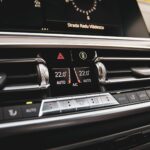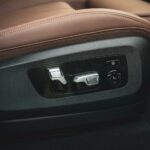In the olden days, premium SUVs were not even a concept. Anything that rode as high as a modern SUV does today was deemed from the get go as a ‘utility vehicle’. Therefore, there was no need of such “luxuries” as leather upholstery or double-zone climate control.
Cars back then were used in completely different ways. SUVs, in the meantime, became the norm and people just can’t seem to get enough of them these days. Since that’s the case, manufacturers have to adapt and offer different drivetrains to the customers, who are now seemingly hellbent on buying only high-riding cars.
It first was the BMW X5 xDrive40e
That’s probably what led to the introduction of the BMW X5 xDrive40e a few years back. Nobody specifically asked for a hybrid X5 and yet, BMW offered it.
Care to guess why?
Because the X5 is one of the best-selling cars it has on sale today and keeping the fleet’s CO2 emissions in check is a tricky ordeal. A hybrid will definitely help out with that, especially considering the tax systems in various countries around the world.
In some places, the less your car pollutes, the less you have to pay to run it.
Wonderful, isn’t it?
The opposite applies too. That’s why the 2-liter diesel engine is the workhorse of Western Europe.
The BMW X5 xDrive40e wasn’t too successful though, no matter how many tax incentives you’d throw at it. The reason? It wasn’t a polished product. It was a first attempt from BMW to try and get customers used to a PHEV SUV.
An exercise that worked. Customers learned about the possibility of having a hybrid X5 but they weren’t sold on that particular model. Then, the new X5 came around and BMW said, from the get go, that a hybrid will still be on the table.
Meet the Refreshed and Improved BMW X5 xDrive45e
The new BMW X5 xDrive45e came with a host of improvements compared to its predecessor. Some engineering bits stayed while others were drastically changed. Among the first category you’ll find the same unchanged exterior appearance.
Just like the xDrive40e before it, the xDrive45e is pretty hard to tell from a “regular” X5. They look exactly the same and, if you remove the rear badge from the tailgate, there’s literally only one giveaway that this is a plug-in hybrid model: the charging port on the left side front fender.
Other than that, everything’s exactly the same.
Our tester came in a beautiful Tanzanite Blue II color, with stunning 21 inch wheels, the M Sport package and blacked out window trims. It was damn near perfect in my book, as these are my favorite wheels in the range right now. Furthermore, that color has been embedded deep inside my head ever since I first saw it on an M4.
It was also almost impossible to spot it as a PHEV as the dark color hid the black contour around the “extra” gas cap on the front fender rather nicely.
Unfortunately, since this was an M Sport model, it did have the M badges on the front fenders and the one on the left side was right on that little door. Naturally, it did attract some attention. It also made things look weird when the car was plugged it, with an M emblem sticking out.
Of course, people hearing the car driving down the street might’ve also noticed something was afoot, as it was completely quiet. At low speeds it does emit a hum to warn pedestrians, but it would still cause a couple of frowns from people as they probably had no idea BMW has an X5 hybrid.
Classy and Premium Inside
The same overall theme applies to the inside of the cabin as well. Compared to a non-electrified X5, there isn’t really much to talk about. Our tester was wearing Vernasca Coffee leather on the inside and there were only a couple of things letting you know something was off.
The center console has a couple of different buttons on it, right next to the start button. They allow you to switch between different driving modes and they are labeled “Hybrid” or “Electric.”
Once you start it up, that feeling becomes certainty as the instrument cluster has a different look compared to what you would find on a gas-burning alternative.
The Driving Experience
The car starts up in the Hybrid mode which is basically run by the on-board computer. In this default driving mode, the car will choose which power source it is using. As is the case with all plug-in hybrid cars, their main goal is to be used as much as possible in electric mode, to cut down emissions and fuel consumption.
Therefore, whether you drive in Electric mode or Hybrid mode doesn’t make a huge difference, as the car will run almost exclusively on electrons in the latter. The differences are subtle but they are there.
For example, in Electric mode the car will not start the engine when you press the gas pedal a bit harder, unlike on the Hybrid mode. Furthermore, in Hybrid mode, once you reach 110 km/h the internal combustion engine will start automatically.
In the Electric mode that won’t be triggered until you reach 140 km/h while the regeneration braking is a bit more powerful. That’s about it when it comes to the driving differences between these two. Even the instrument cluster looks the same when you’re using one of them.
Then there’s Sport mode and this is where your X5 will start feeling a bit more familiar. In Sport mode you even get a rev counter on the right side of the infotainment screen. It still goes counter-clockwise but it does offer a familiar feeling. The fact that the internal combustion engine also starts up and offers a familiar growl contributes as well to that feeling.
So how is it to drive? Well, the technical side of things is where the BMW xDrive45e model truly sets itself apart from its predecessor.
Whereas the old X5 xDrive40e used a 2-liter 4-cylinder engine, the new model uses a better powerplant as an alternative – the B58 3-liter straight six. The extra 2 cylinder don’t only balance the engine a lot better than before, they also bring more power to the table, with a total system output of 394 PS and up to 600 Nm of torque.
Those numbers are made up by the 286 PS of the internal combustion engine and the 113 HP of the electric motor which replaces the torque converter in the grand scheme of things, being located right between the engine and the gearbox. This way, the electric motor can be used to start up the ICE and for other functions.
Therefore, we’re looking a car with two more cylinders and more power and yet, the emissions are lower while the performance went up.
How is that possible? Well, it’s all doable thanks to BMW’s fourth-generation batteries and this is an even bigger jump compared to the old PHEV X5 than it’s the case under the hood.
Whereas the old hybrid X5 had a 9.2 kWh battery, the new one can store more than 2.5 times that, being rated for 24 kWh out of which you can use 21 kWh. So that’s a big hike, even though the physical size of the battery didn’t change that much.
It all goes down to the energy density. The battery is actually located in the exact same place as it was before, over the rear axle, to keep things balanced. It does cut into the boot though and the PHEV model offers 150 liters of luggage space less than the conventional models, at 500 liters.
That’s the same reason why you can’t get the X5 xDrive45e in a 7-seat configuration.
As for the driving, it’s a typical BMW X5 experience with a twist. If you have enough juice in the battery, most of your driving around town will be eerily silent. You’ll spend most of your trip in the EV mode which means the only sounds protruding into the cabin will be coming from the tires and the wind. The xDrive45e also comes with air suspension as standard, so you’ll basically be feeling like you’re gliding around instead of driving.
If you run out of power or enter Sport mode, you’ll instantly notice the differences compared to its predecessor or any other X5 in the range right now, as a matter of fact. That’s because the two motors are working brilliantly in tandem and offer quite a unique feeling.
The one that comes close is probably the BMW X5 M50i but any other X5 model offered on sale today (with the exception of the X5 M as I didn’t have the chance to drive that one yet) falls short in terms of handling and feeling. And yes, I’m including the otherwise brilliant M50d model here too.
The reason for that is because the moment you step on the accelerator, the car responds. The pedal response is instantaneous and that’s to be expected, as the electric motor doesn’t have to rev up or spool up boost to get going.
Sure, the full might of the 600 Nm of torque available doesn’t hit you all at once, it takes a half a second to get the internal combustion engine up to speed. But the initial reaction is right there. And the two power sources are intertwined perfectly and you barely feel it when the petrol unit kicks in.
Keep the pedal glued to the floor and speed just keeps ticking up. This car picks up speed at an alarming rate. It may be a hybrid, 2.5-ton monster but it can move. 0-62 takes just 5.6 seconds and you’ll go all the way up to 250 km/h (155 mph) if you dare.
It all feels muscular and smooth overall, something you don’t get in other models. The diesels are simply too noisy and too… diesel-like if you will, while the petrol, excepting the 4.4-liter V8, just don’t bring the same muscular feeling about when it comes to driving all out.
As for the corners, if straight line performance can’t really be matched by the other models in the range, it’s in the bends where the X5 xDrive45e starts to run out of breath. The suspension works great when it comes to keep you comfortable. The adaptive dampers we had along with the air ride kept everything nice and kosher as long as you didn’t try to push the X5 way beyond its comfort zone.
However, once you start trying to find its limits, you’ll learn that the added weight does have an impact on handling. It’s not a terrible experience, mind you, and up to about 8/10 the car feels rather neutral. Yet, it’s that last 20 percent that reminds you this car is carrying batteries in the back after all. Then again, 99 pecent of the customers will never take it past 5/10 so they probably won’t ever say this thing doesn’t handle like it should.
Consumption and Range
But what about the fuel consumption and battery range? After all, this is a PHEV and those numbers matter. The truth is that the numbers I got during my time with the car might not be accurate. The review was carried out on rather empty streets as everyone was staying inside.
Therefore, the 70 kilometers (43.7 miles) of range I got out of a full battery might not be easily replicated once traffic goes back to normal. Once the juice in the cells ran out, the car showed an average fuel consumption of about 10 l/100 km (23.5 mpg).
That’s actually really good but, once again, the city was rather empty, a fact confirmed by my average speed of 40 km/h (25 mph) which would never be possible in normal, non-COVID-19 traffic.
That low fuel consumption figure was capable because the car will often shut off its engine, even if the battery shows 0 percent. Whenever it can muster up some electrons from the battery, the car will use them to move around. It will switch off the engine as you’re approaching a red light, will use the electric motor to cruise or start off and so on.
What I will mention is that over the course of my time with the car I burned about 2 gallons of petrol and I covered some 220 miles just to put things into perspective. And yes, I did charge it as often as possible.
Should I Buy One?
That said, I think the 2020 BMW X5 xDrive45e should be on your list if you have a charger available and your daily commute is around 40 miles. If you can charge this car, you’ll be spending most of your time driving electric, without having to stop at a gas station unless you’re going for a longer trip.
It will do all the things an X5 is expected to do and deals with all the shortcomings the previous model had, including the short electric range.
Couple that with the advantages certain countries offer for plug-in hybrids and I think this is the best model you could buy in the current X5 range today, if you don’t need a V8 under the hood.



































































